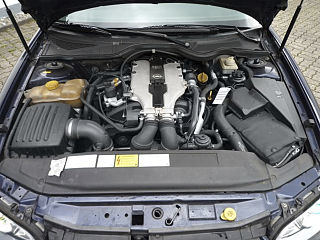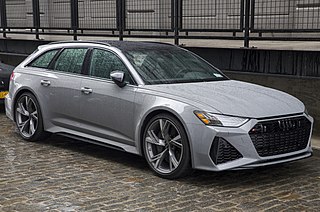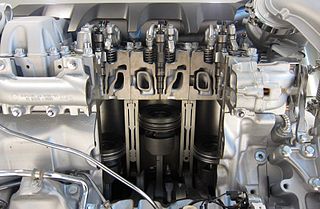The straight-five engine is a piston engine with five cylinders mounted in a straight line along the crankshaft.
The GM Ecotec engine, also known by its codename L850, is a family of all-aluminium inline-four engines, displacing between 1.4 and 2.5 litres. Confusingly, the Ecotec name was also applied to both the Buick V6 Engine when used in Holden Vehicles, as well as the final DOHC derivatives of the previous GM Family II engine; the architecture was substantially re-engineered for this new Ecotec application produced since 2000. This engine family replaced the GM Family II engine, the GM 122 engine, the Saab H engine, and the Quad 4 engine. It is manufactured in multiple locations, to include Spring Hill Manufacturing, in Spring Hill, Tennessee, with engine blocks and cylinder heads cast at Saginaw Metal Casting Operations in Saginaw, Michigan.

The BMW M42 is a DOHC straight-four petrol engine which was produced from 1989-1996. It is BMW's first mass-production DOHC engine and was produced alongside the BMW M40 SOHC four-cylinder engine as the higher performance engine.

The BMW M43 is an SOHC four-cylinder petrol engine which was produced from 1991-2002. The M43 powered base-model cars, while higher performance models at the time were powered by the BMW M42 and BMW M44 DOHC engines. The M43 was produced at the Steyr engine plant.

General Motors' Opel subsidiary in Europe designed a compact V6 engine with an unusual 54° vee angle. It was an iron block/aluminum head DOHC design with four valves per cylinder. All 54° engines were assembled at Ellesmere Port in England.

The Audi RS 6 is a high-performance variant of the Audi A6 range, produced by the high-performance subsidiary company Audi Sport GmbH, for its parent company Audi AG, a subsidiary of the Volkswagen Group, from 2002 onwards.

Common rail direct fuel injection is a direct fuel injection system built around a high-pressure fuel rail feeding solenoid valves, as opposed to a low-pressure fuel pump feeding unit injectors. High-pressure injection delivers power and fuel consumption benefits over earlier lower pressure fuel injection, by injecting fuel as a larger number of smaller droplets, giving a much higher ratio of surface area to volume. This provides improved vaporization from the surface of the fuel droplets, and so more efficient combining of atmospheric oxygen with vaporized fuel delivering more complete combustion.
Jetronic is a trade name of a manifold injection technology for automotive petrol engines, developed and marketed by Robert Bosch GmbH from the 1960s onwards. Bosch licensed the concept to many automobile manufacturers. There are several variations of the technology offering technological development and refinement.

The Audi S6 is the performance variant of the Audi A6, an executive car produced by German automaker Audi. It went on sale in 1994, shortly after the "A6" designation was introduced, replacing the "100" nameplate.

An engine control unit (ECU), also called an engine control module (ECM), is a device which controls multiple systems of an internal combustion engine in a single unit. Systems commonly controlled by an ECU include the fuel injection and ignition systems.

The Family II is a straight-4 piston engine that was originally developed by Opel in the 1970s, debuting in 1981. Available in a wide range of cubic capacities ranging from 1598 to 2405 cc, it simultaneously replaced the Opel CIH and Vauxhall Slant-4 engines, and was GM Europe's core mid-sized powerplant design for much of the 1980s, and provided the basis for the later Ecotec series of engines in the 1990s.

In a spark ignition internal combustion engine, ignition timing is the timing, relative to the current piston position and crankshaft angle, of the release of a spark in the combustion chamber near the end of the compression stroke.
Renix was a joint venture by Renault and Bendix that designed and manufactured automobile electronic ignitions, fuel injection systems, electronic automatic transmission controls, and various engine sensors. Major applications included various Renault and Volvo vehicles. The name became synonymous in the U.S. with the computer and fuel injection system used on the AMC/Jeep 2.5 L I4 and 4.0 L I6 engines.

Digifant is an Engine Management System operated by an Engine Control Unit that actuates outputs, such as fuel injection and ignition systems, using information derived from sensor inputs, such as engine speed, exhaust oxygen and intake air flow. Digifant was designed by Volkswagen Group, in cooperation with Robert Bosch GmbH.
Trionic T5.5 is an engine management system in the Saab Trionic range. It controls ignition, fuel injection and turbo boost pressure. The system was introduced in the 1993 Saab 9000 2.3 Turbo with B234L and B234R engine.
Manifold injection is a mixture formation system for internal combustion engines with external mixture formation. It is commonly used in engines with spark ignition that use petrol as fuel, such as the Otto engine, and the Wankel engine. In a manifold-injected engine, the fuel is injected into the intake manifold, where it begins forming a combustible air-fuel mixture with the air. As soon as the intake valve opens, the piston starts sucking in the still forming mixture. Usually, this mixture is relatively homogeneous, and, at least in production engines for passenger cars, approximately stoichiometric; this means that there is an even distribution of fuel and air across the combustion chamber, and enough, but not more air present than what is required for the fuel's complete combustion. The injection timing and measuring of the fuel amount can be controlled either mechanically, or electronically. Since the 1970s and 1980s, manifold injection has been replacing carburettors in passenger cars. However, since the late 1990s, car manufacturers have started using petrol direct injection, which caused a decline in manifold injection installation in newly produced cars.

Volkswagen Group have produced a number of W12 internal combustion piston engines for their Volkswagen, Audi, and Bentley marques, since 2001.

The Volkswagen-Audi V8 engine family is a series of mechanically similar, gasoline-powered and diesel-powered, V-8, internal combustion piston engines, developed and produced by the Volkswagen Group, in partnership with Audi, since 1988. They have been used in various Volkswagen Group models, and by numerous Volkswagen-owned companies. The first spark-ignition gasoline V-8 engine configuration was used in the 1988 Audi V8 model; and the first compression-ignition diesel V8 engine configuration was used in the 1999 Audi A8 3.3 TDI Quattro. The V8 gasoline and diesel engines have been used in most Audi, Volkswagen, Porsche, Bentley, and Lamborghini models ever since. The larger-displacement diesel V8 engine configuration has also been used in various Scania commercial vehicles; such as in trucks, buses, and marine (boat) applications.












